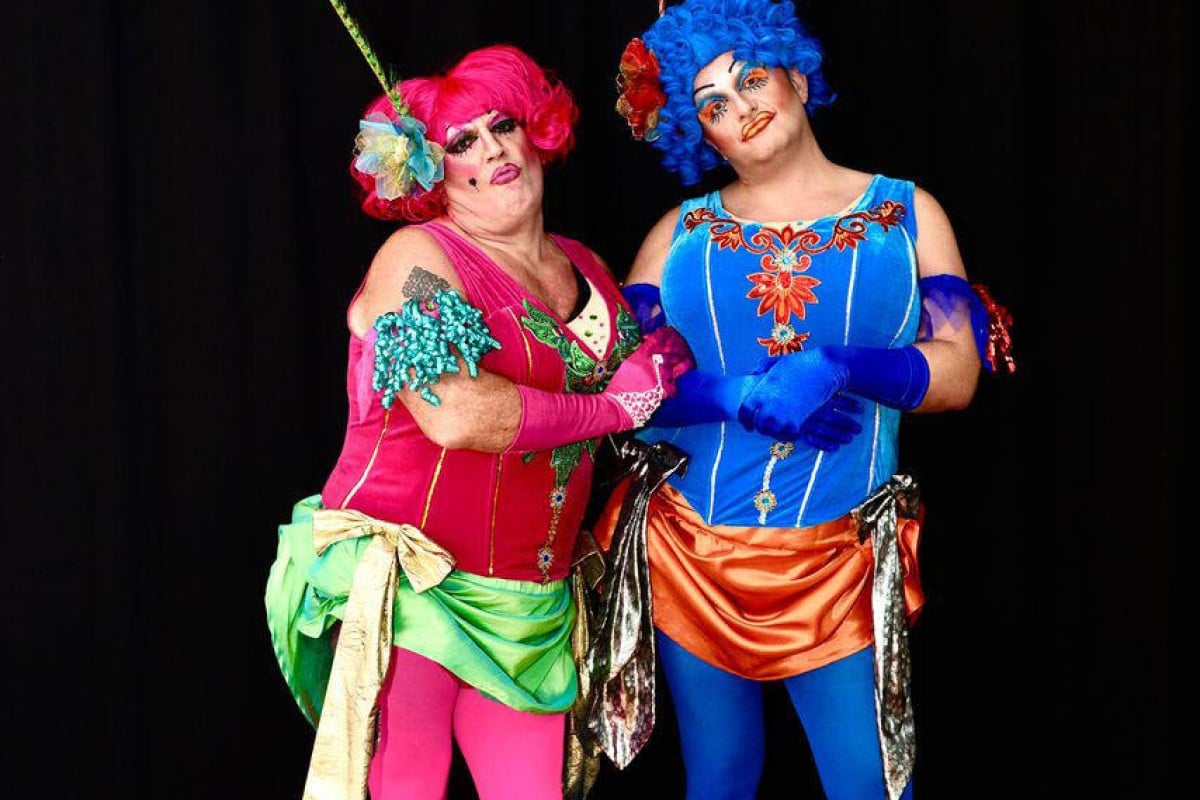
It's pantomime season! Young Post takes a look at the history of the hilarious panto dames - men dressed as women - who always steal the show
 Terry Hart (left) and Bobby Burns play Cinderella's Ugly Bros, uh, Sisters.
Terry Hart (left) and Bobby Burns play Cinderella's Ugly Bros, uh, Sisters.In ancient Greece, where Western theatre originated, the stage was a bit of a boys’ club – women weren’t allowed to act, and female roles were portrayed by men. The same was true of early Roman theatre. Women were famously forbidden from acting during Shakespeare’s heyday by the country’s strict Puritanical leaders. The prohibition often meant that males – usually teenage boys – took the female roles, dressing in women’s clothing. (As anyone studying Shakespeare probably knows, his Twelfth Night and As You Like It feature female characters who disguise themselves as men, meaning performances at the time were boys dressed as girls dressed as boys …)
Women were allowed onstage in the West with the start of the Restoration period in Britain, but the custom of dressing in the outfits of the opposite sex continued. (In fact, when women returned to the stage, many of them took “breeches roles”, when they dressed as men.) And it continues today in one type of show – the Christmas pantomime.
Pantomime is one genre on which IB drama students can write a presentation; those at Independent Schools Foundation Academy might be encouraged to choose it, as their teacher, Adam Walker, is directing Hong Kong Players’ annual panto this year.
“Panto is a great way for young people to be introduced to the stage in a fun way. The interaction element brings a playfulness, and trains actors to really hone their skills as a performer.”
“I only started my career in theatre and acting because I was dragged up on stage at four years old to meet the dame during the songsheet part of the performance. Many famous actors began in the same way. We at Hong Kong Players call it “Panto Joy”, and it’s true from the very first rehearsal to the last performance, we’ve grown from strangers into a small community joined by our love and passion for striving for that joy.”
Traditionally, the festive show features “the principal boy” – a female in the main lead role; think Aladdin, or Prince Charming. There is also always a “pantomime dame”, usually the mother of one of the characters, who is almost always played by a male. But unlike the young actors of Shakespeare’s time, who were supposed to look feminine, a panto dame should obviously be a man in a dress.
In next month’s Cinderella, there are not one, but two very obvious men in dresses: the Ugly Sisters. Played by Bobby Burns and Terry Hart, the pair fit the bill, with their rugby players’ build, and basketball players’ height: in their costumes, each of them stands at more than six feet tall.
But their manliness is just an added bonus; Walker was mainly concerned about character. “The panto dame (or dames this year!) are an essential part of the panto spirit. They are naughty, bright and unpredictable,” he says. “They give light relief for the audience and can often steal the show.”
According to London’s Victoria and Albert Museum, this character started to appear in panto in the early 19th century, with the role evolving over the next 50 years, and not changing in the 100 or so years since then. It hasn't changed much, with the dame being the character who interacts with the audience and wearing crazy costumes. Walker adds that they need to be “larger-than-life characters who bring a lot of the humour to the audience. … They serve as the abrasion to the sweetness of the fairy story.”
Burns and Hart are both experienced amateur performers, but with very different experiences. Burns is a newbie to playing this very specific role, but excitement is keeping any nerves at bay. “I went to watch panto last year, and thought it was fantastic, so I really wanted to be a part of it this year. He adds: “I’ve played other lead roles, including the Beast in Beauty and the Beast, and Sweeny Todd, so this is very different from them.”
“There’s a lot of comedy, obviously, which is one of the challenges. Another is learning that women’s legs must hurt a lot – wearing heels takes practice!”
Hart, on the other hand, has played a dame eight times in Hong Kong, (as well as doing it in Britain), but felt compelled to auditioned again this year he loves how people react to the show.
“Panto, unlike any other genre brings so much joy,” he says. “It’s so much fun: lots of lovely people, songs, jokes, costumes, and a great time.”
Hart is also inspired by the younger members of the show, all students at or very recent graduates of international schools in Hong Kong. “They are so full of energy and talent, and bring a real vibrancy to the show,” he says. “It’s also lovely to watch how they learn, and grow from the first rehearsal to the final show.”
But perhaps the biggest appeal this year is establishing a bond of brotherhood – in the guise of sisterhood.
“Playing opposite another dame is always fun, bouncing off each other and creating double the trouble. The space this year will be fantastic – and with two of us on stage, there probably won’t be much room for anyone else!”
That space is a giant, inflatable, upside-down purple cow, the home of the first ever Hong Kong Udderbelly Festival. The Festival started in 2000, and is a major part of Scotland’s Edinburgh Festival, as well as an annual event in London.
Tickets for Cinderella and other Udderbelly shows are available from HK Ticketing.
